Perception and acceptability of social robots in healthcare: ethnographic research based on a qualitative case study
Titolo Rivista SALUTE E SOCIETÀ
Autori/Curatori Sara Canella, Izdor Malkar, Igor Robert Roj, Vojko Flis
Anno di pubblicazione 2024 Fascicolo 2024/2
Lingua Inglese Numero pagine 15 P. 88-102 Dimensione file 230 KB
DOI 10.3280/SES2024-002006
Il DOI è il codice a barre della proprietà intellettuale: per saperne di più
clicca qui
Qui sotto puoi vedere in anteprima la prima pagina di questo articolo.
Se questo articolo ti interessa, lo puoi acquistare (e scaricare in formato pdf) seguendo le facili indicazioni per acquistare il download credit. Acquista Download Credits per scaricare questo Articolo in formato PDF

FrancoAngeli è membro della Publishers International Linking Association, Inc (PILA)associazione indipendente e non profit per facilitare (attraverso i servizi tecnologici implementati da CrossRef.org) l’accesso degli studiosi ai contenuti digitali nelle pubblicazioni professionali e scientifiche
Medical care is changing, driven both by necessity as well as innovation. The European healthcare sector’s digital transformation involves the rapid adoption of advanced technologies such as AI, robotics, autonomous systems, and Big Data. The study “Perception and acceptability of social robots in healthcare: ethnographic research based on a qualitative case study” investigates interaction with and acceptability of social robots in a pilot project based in Maribor Hospital, as a part of the European HosmartAI project. These robots functioned largely to assist patients and as “administrative support” for the nurses and doctors. This study focuses on the interactions of healthcare personnel with robots, including any emotions or fears and barriers that arose. The goal was to understand robot acceptance and challenges from a human-centric and individual perspective, focussing on key stakeholders that both use and develop these robots. All stakeholders are part of HosmartAI Living Labs, which works through collaboration to design and deliver advanced technologies.
Parole chiave:robot sociali; intelligenza artificiale; assistenza sanitaria; competenze digitali; accettazione della tecnologia; ospedale intelligente.
Sara Canella, Izdor Malkar, Igor Robert Roj, Vojko Flis, Perception and acceptability of social robots in healthcare: ethnographic research based on a qualitative case study in "SALUTE E SOCIETÀ" 2/2024, pp 88-102, DOI: 10.3280/SES2024-002006